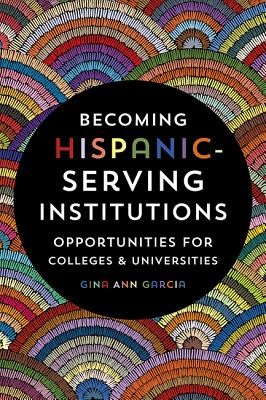
- We will send in 10–14 business days.
- Author: Gina Ann Garcia
- Publisher: Johns Hopkins University Press
- ISBN-10: 1421427370
- ISBN-13: 9781421427379
- Format: 15 x 22.6 x 1.3 cm, softcover
- Language: English
- SAVE -10% with code: EXTRA
Reviews
Description
How can striving Hispanic-Serving Institutions serve their students while countering the dominant preconceptions of colleges and universities?
Winner of the AAHHE Book of the Year Award by the American Association of Hispanics in Higher Education
Hispanic-Serving Institutions (HSIs)--not-for-profit, degree-granting colleges and universities that enroll at least 25% or more Latinx students--are among the fastest-growing higher education segments in the United States. As of fall 2016, they represented 15% of all postsecondary institutions in the United States and enrolled 65% of all Latinx college students. As they increase in number, these questions bear consideration: What does it mean to serve Latinx students? What special needs does this student demographic have? And what opportunities and challenges develop when a college or university becomes an HSI?
In Becoming Hispanic-Serving Institutions, Gina Ann Garcia explores how institutions are serving Latinx students, both through traditional and innovative approaches. Drawing on empirical data collected over two years at three HSIs, Garcia adopts a counternarrative approach to highlight the ways that HSIs are reframing what it means to serve Latinx college students. She questions the extent to which they have been successful in doing this while exploring how those institutions grapple with the tensions that emerge from confronting traditional standards and measures of success for postsecondary institutions.
Laying out what it means for these three extremely different HSIs, Garcia also highlights the differences in the way each approaches its role in serving Latinxs. Incorporating the voices of faculty, staff, and students, Becoming Hispanic-Serving Institutions asserts that HSIs are undervalued, yet reveals that they serve an important role in the larger landscape of postsecondary institutions.
EXTRA 10 % discount with code: EXTRA
The promotion ends in 19d.21:25:57
The discount code is valid when purchasing from 10 €. Discounts do not stack.
- Author: Gina Ann Garcia
- Publisher: Johns Hopkins University Press
- ISBN-10: 1421427370
- ISBN-13: 9781421427379
- Format: 15 x 22.6 x 1.3 cm, softcover
- Language: English English
How can striving Hispanic-Serving Institutions serve their students while countering the dominant preconceptions of colleges and universities?
Winner of the AAHHE Book of the Year Award by the American Association of Hispanics in Higher Education
Hispanic-Serving Institutions (HSIs)--not-for-profit, degree-granting colleges and universities that enroll at least 25% or more Latinx students--are among the fastest-growing higher education segments in the United States. As of fall 2016, they represented 15% of all postsecondary institutions in the United States and enrolled 65% of all Latinx college students. As they increase in number, these questions bear consideration: What does it mean to serve Latinx students? What special needs does this student demographic have? And what opportunities and challenges develop when a college or university becomes an HSI?
In Becoming Hispanic-Serving Institutions, Gina Ann Garcia explores how institutions are serving Latinx students, both through traditional and innovative approaches. Drawing on empirical data collected over two years at three HSIs, Garcia adopts a counternarrative approach to highlight the ways that HSIs are reframing what it means to serve Latinx college students. She questions the extent to which they have been successful in doing this while exploring how those institutions grapple with the tensions that emerge from confronting traditional standards and measures of success for postsecondary institutions.
Laying out what it means for these three extremely different HSIs, Garcia also highlights the differences in the way each approaches its role in serving Latinxs. Incorporating the voices of faculty, staff, and students, Becoming Hispanic-Serving Institutions asserts that HSIs are undervalued, yet reveals that they serve an important role in the larger landscape of postsecondary institutions.


Reviews